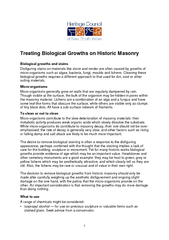/


1 2 a group of chemicals known as quaternary ammonium compounds These are commonly used and are discussed below 149 bleach 151 though effective at killing microorganisms bleach can be very ID: 98603
Download Pdf The PPT/PDF document "Treating Biological Growths on Historic ..." is the property of its rightful owner. Permission is granted to download and print the materials on this web site for personal, non-commercial use only, and to display it on your personal computer provided you do not modify the materials and that you retain all copyright notices contained in the materials. By downloading content from our website, you accept the terms of this agreement.
1 Treating Biological Growths on Historic Masonry Biological growths and stains Disfiguring stains on materials like stone and render are often caused by growths of microorganisms such as algae, bacteria, fungi, moulds and lichens. Cleaning these biological growths requires a different approach to that used for dirt, soot or other soiling materials. Micro Microorganisms generally grow on walls that are regularly dampened by rain. Though visible at the surface, the bulk of the organism may be hidden in pores within the masonry material. Lichens are a combination of an alga and a fungus and have some leaf-like forms that obscure the surface, while others are visible only as clumps of tiny black dots. All have a sub-surface network of filaments. To clean or not to clean Microorganisms contribute to the slow deterioration of masonry materials: their metabolic activity produces weak organic acids which slowly dissolve the substrate. While micro-organisms do contribute to masonry decay, their role should not be over-emphasised: the rate of decay is generally very slow, and other factors such as rising or falling damp and salt attack are likely to be much more important. The desire to remove biological staining is often a response to the disfiguring appearance, perhaps combined with the thought that the staining implies a lack of care for the building, sculpture or monument. Yet for many historic works biological growths provide evidence of age which may be an important value. Headstones and other cemetery monuments are a good example: they may be host to green, grey or yellow lichens which may be aesthetically attractive, and which clearly tell us they are old. Also, the lichens may be rare or unusual and of value in their own right. The decision to remove biological growths from historic masonry should only be made after carefully weighing up the aesthetic disfigurement and ongoing slight damage on the one hand, with the patina that the micro-organisms provide on the other. An important consideration is that removing the growths may do more damage than doing nothing. What to use A range of chemicals might be considered: • isopropyl alcohol — for use on precious sculpture or valuable items such as stained glass. Seek advice from a conservator. 2 a group of chemicals known as quaternary ammonium compounds. These are commonly used and are discussed below. • bleach — though effective at killing micro-organisms, bleach can be very damaging to historic masonry. It should not be used except in extreme circum Quaternary ammonium compounds Known as ‘quats’, these compounds are the active ingredients in disinfectants and have a range of chemical names including the widely used benzalkonium chloride. Many quats are produced for different purposes: the aim is to find a readily available one that is free of unnecessary ingredients such as colours and fragrances. Algaecides used for swimming pools, such as ‘Alginox’, are one possibility. Recently introduced to Australia, ‘Wet and Forget’ is marketed as a biological stain remover. Whichever quat is used, they should always be diluted with water to a solution of about 20 g/litre (2%). How to clean Some micro-organisms need to be active in order to kill them off, so after a dry spell it may be necessary to thoroughly wet the surface some days ahead of treatment. Wearing goggles, gloves and protective clothing spray or brush the quat solution over the area to be cleaned. Lichens require a thorough application to break down their waxy coating. Do not apply if there is the likelihood of rain that day. Wait three to four weeks and wash down with clean water. Light brushing may assist removal of debris. Treat again if necessary, but accept a less-total clean as pleasing evidence of age. What not to use Never use acids or alkalis, nor high pressure water or sandblasting on historic masonry. And never use common domestic cleaners and mould removers: many contain both bleach (sodium hypochlorite) and caustic soda (sodium hydroxide) and can be very damaging. Written by David Young OAM For the Technical Advisory Panel of the Heritage Council of NSW April 2005